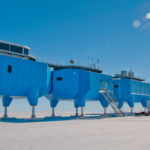At Halley, balloon launches take place every day at 11am. A device called a radiosonde hangs beneath the helium-filled balloon and measures temperature, pressure and humidity. From GPS we can also calculate wind speed and direction. Measurements are taken about once a second and transmitted back to base.
The balloon can travel up to 35km in height and expand to the size of a double decker bus before bursting. They are launches at more than 400 locations, from land and ships, around the world at the same time each day. The data is used by forecasters to provide a detailed snapshot of conditions throughout the lower atmosphere. Climate scientists are also interested in the long-term records of temperatures at different heights amongst other things.
BAS analysis of weather balloon data collected over the past 30 years has shown that the Antarctic atmosphere has warmed below 8km and cooled above this height. This pattern is seen globally and is the expected signature of increases in greenhouse gases, such as carbon dioxide. However, the warming at 5km over the Antarctic during winter is over three times the global average rate of warming at this level. This means even in parts of Antarctica where no warming has been observed at the surface, like Halley, we are still seeing significant changes higher up.



